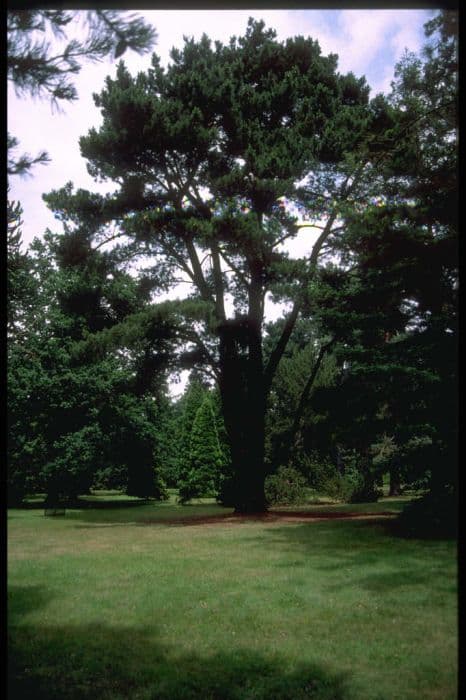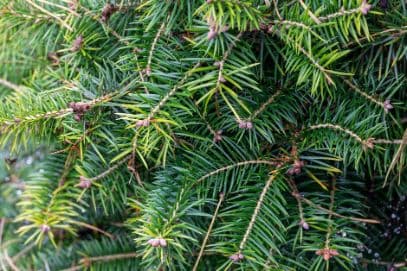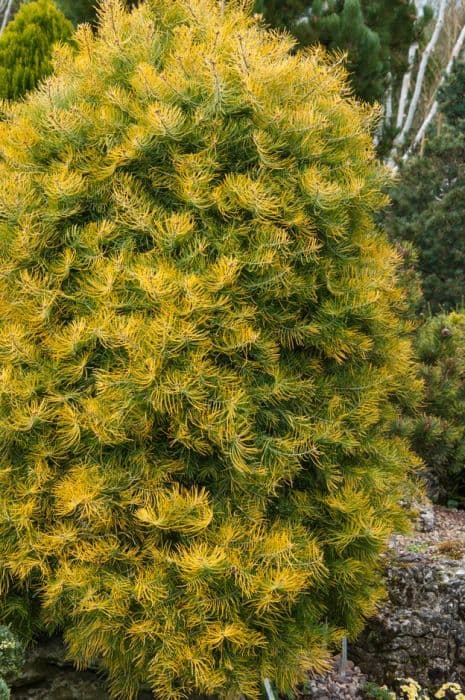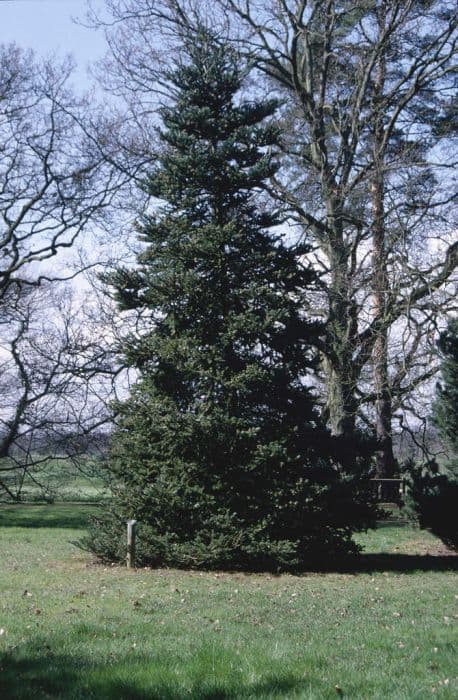Monterey Pine Pinus radiata

ABOUT
The Monterey pine, as it's commonly known, is characterized by its distinctive evergreen foliage that remains lush throughout the year. The needles on this tree are arranged in clusters, typically of three, and possess a vivid green hue. They are slender and can be quite long, providing a soft texture when brushed against. On closer examination, you would notice that the bark of the Monterey pine is textured and furrowed, offering a rugged appearance with a color palette that ranges from dark brown to a more muted gray. Throughout the year, this tree produces cones, which start off in a green state, and as they mature, they turn into a glossy brown. These cones are woody, hard to the touch, and have a classic conical shape with a slightly curved point. The Monterey pine has a symmetrical shape, with branches that spread outwards from the central trunk. The lower branches tend to droop slightly, while the upper section of the tree branches upward, giving it a rounded or pyramidal silhouette. This conifer is noted for its propensity to adapt and thrive in various conditions, often contributing to its popularity in cultivated landscapes. When you stand close to a Monterey pine, it exudes a refreshing scent, reminiscent of the clean, crisp air of a forest. This combines with its aesthetic to make it not only an attractive plant in many settings but also one that can enhance the sensory appeal of its environment.
About this plant
 Names
NamesFamily
Pinaceae
Synonyms
Monterey Pine, Insignis Pine, Radiata Pine
Common names
Pinus insignis, Pinus binata.
 Toxicity
ToxicityTo humans
The common name for Pinus radiata is Monterey pine. Generally, Monterey pine is not considered toxic to humans. Ingestion of pine needles or other parts of the tree typically does not lead to poisoning. However, it's important to note that eating large quantities of pine needles can cause physical irritation or gastrointestinal discomfort due to their fibrous nature. In rare cases, individuals may have allergic reactions.
To pets
For Monterey pine, there is no widespread evidence indicating significant toxicity to pets such as dogs and cats. However, like in humans, ingestion of large amounts of pine needles can potentially cause gastrointestinal upset or obstruction. It is always best to monitor pets and prevent them from chewing on or ingesting any part of the plant, as individual reactions can vary.
 Characteristics
CharacteristicsLife cycle
Perennials
Foliage type
Evergreen
Color of leaves
Green
Height
50-100 feet (15-30 meters)
Spread
20-40 feet (6-12 meters)
Plant type
Tree
Hardiness zones
7-10
Native area
California
Benefits
 General Benefits
General Benefits- Reforestation: Pinus radiata, commonly known as Monterey pine, is widely used for reforestation in temperate regions due to its fast growth and high adaptability to different soil types.
- Timber Production: It is a major source of timber, providing softwood that is used for making furniture, building construction, and paper products.
- Erosion Control: Its extensive root system helps stabilize soil and prevent erosion, particularly beneficial in coastal areas and hillsides.
- Ornamental Use: Monterey pine is often used as an ornamental tree in gardens and parks due to its attractive shape and foliage.
- Windbreaks and Shelterbelts: Planting them in rows can protect against wind erosion and provide shelter for crops and livestock.
- Carbon Sequestration: As a fast-growing species, it can capture substantial amounts of carbon dioxide, contributing to climate change mitigation.
- Habitat and Biodiversity: Monterey pine forests support a range of wildlife species, offering a habitat for birds, mammals, and insects.
 Medical Properties
Medical Properties- Antioxidant: Pinus radiata needle extracts have been found to contain compounds that exhibit antioxidant properties, which are important for protecting cells from damage caused by free radicals.
- Anti-inflammatory: The plant contains constituents that may help reduce inflammation, potentially benefiting conditions characterized by inflammation.
- Antimicrobial: Some studies indicate that Pinus radiata has antimicrobial effects, which could be useful in combating certain bacteria and fungi.
- Respiratory health: There are indications that preparations made from Pinus radiata needles may have beneficial effects for respiratory conditions due to their expectorant properties.
 Air-purifying Qualities
Air-purifying QualitiesThis plant is not specifically known for air purifying qualities.
 Other Uses
Other Uses- Monterey pine needles can be used in basketry, where the long and flexible needles are suitable for creating intricate woven baskets.
- The resin from Monterey pine trees can be tapped and used as a natural adhesive or sealant for various traditional crafts and DIY projects.
- Young Monterey pine cones can be picked and used as natural decorations, potentially painted or lacquered to create holiday ornaments or centerpieces.
- The bark of the Monterey pine provides a unique textural material for garden mulch, offering a natural way to suppress weeds and retain soil moisture.
- Artists may use slices of Monterey pine branches or trunks as canvases for wood burning or painting, taking advantage of the natural grain patterns.
- The tannins found in the Monterey pine bark can be utilized in the tanning of leather to imbue the material with resilience and color.
- Monterey pine wood shavings and sawdust can be repurposed as bedding material for pets, particularly in small rodents' enclosures, due to its absorptive qualities.
- Due to the high pitch content, the wood of the Monterey pine can be used as a natural fire starter, enabling quick and easy ignition for bonfires or wood stoves.
- The tall and straight trunks of the Monterey pine are sometimes used in traditional construction to create robust, rustic flagpoles or totem poles.
- Fallen Monterey pine needles are used as an acidifying mulch for acid-loving plants like azaleas and blueberries, helping to create the low pH conditions they thrive in.
Interesting Facts
 Feng Shui
Feng ShuiThe Monterey Pine is not used in Feng Shui practice.
 Zodiac Sign Compitability
Zodiac Sign CompitabilityThe Monterey Pine is not used in astrology practice.
 Plant Symbolism
Plant Symbolism- Resilience - Pinus radiata, commonly known as the Monterey pine, is a species known for its ability to adapt and thrive in various climates, making it a symbol of resilience and adaptability.
- Longevity - Like many pine species, the Monterey pine represents longevity due to its potential for a long lifespan, reflecting endurance and timeless existence.
- Steadfastness - Pines often symbolize steadiness and unwavering strength. The Monterey pine, with its sturdy trunk and evergreen foliage, is no exception, embodying the quality of being steadfast.
- Hope - The evergreen nature of Monterey pine with its continuous green needles throughout seasons symbolizes hope and eternal life, as it remains vibrant even during the winter months.
- Sanctuary - Pine trees, in general, are associated with creating a space of peace and sanctuary, perhaps due to the calming presence of their expansive green canopies; Monterey pines share this association.
 Water
WaterThe Monterey Pine, commonly known as Pinus radiata, should be watered deeply but infrequently to mimic its natural habitat. Newly planted trees require watering every week with around 5 gallons per tree, ensuring moisture reaches the root zone. Once established, reduce the frequency to every 2 to 4 weeks, depending on the weather conditions, with increased amounts up to 15 gallons per watering session to encourage deep root growth. During extended dry spells, additional water may be necessary. It's important not to overwater to prevent root rot, which this species can be prone to in poorly drained soils.
 Light
LightThe Monterey Pine thrives in full sun, meaning it requires at least 6 hours of direct, unfiltered sunlight each day. The best spot for planting it is in an open area where it can receive ample sunlight throughout the day. Avoid placing it in shaded areas, as lack of sufficient light can hamper its growth and health.
 Temperature
TemperatureThe Monterey Pine prefers temperate climates and can tolerate a temperature range roughly between 20°F and 100°F. The ideal temperature for this species is between 60°F and 75°F. It is not well suited for extreme cold or prolonged high temperatures, which can stress the tree.
 Pruning
PruningPruning the Monterey Pine is essential for removing dead or diseased branches and shaping the tree for structural integrity. The best time to prune is in late winter or early spring before new growth begins. Pruning should be done selectively and not more often than once a year to prevent unnecessary stress to the tree.
 Cleaning
CleaningNot needed
 Soil
SoilMonterey Pine prefers well-draining, acidic soil with pH levels between 5.0-6.5. A mix of peat, sand, and loamy soil often works best for optimal growth.
 Repotting
RepottingMonterey Pine should be repotted every 2-4 years, depending on growth rate and pot size, to prevent the roots from becoming pot-bound.
 Humidity & Misting
Humidity & MistingMonterey Pine thrives in moderate humidity conditions and does not require high humidity to grow well.
 Suitable locations
Suitable locationsIndoor
Use a large pot with drainage, place in bright light.
Outdoor
Full sun, well-draining soil, protect from strong winds.
Hardiness zone
7-10 USDA
 Life cycle
Life cycleThe Monterey pine (Pinus radiata) begins its life cycle as a seed, which after dispersal from the parent's cone, germinates when conditions are right, typically in moist, well-drained soil. The germinated seed gives rise to a seedling, which establishes itself with a root system and begins to grow vertically, developing its characteristic pine needle foliage. With sufficient light, water, and nutrients, the seedling grows into a juvenile tree, forming a woody stem and branches, and increases in height and girth. As the tree matures, it enters the reproductive stage, developing male cones that produce pollen and female cones that, once pollinated, will develop seeds. The mature Monterey pine can produce cones annually, with the cycle of pollination, seed development, and dispersal continuing the species' propagation. The tree can live for several decades, during which it may encounter various stages of growth, reproduction, and eventually senescence, leading to its natural death.
 Propogation
PropogationPropogation time
Spring-Early Summer
Monterey Pine, commonly known as Pinus radiata, is typically propagated through seeds as the most popular method. Optimal time for sowing seeds is in late winter to early spring when temperatures are consistent for germination. The seeds are first stratified, which involves chilling them in a refrigerator at about 34-40 degrees Fahrenheit (1-4 degrees Celsius) for a period of 4-6 weeks to break dormancy. After stratification, the seeds are sown in well-draining soil in containers or seedbeds and lightly covered with soil. The seeds require consistent moisture and ample sunlight to germinate successfully. Seedlings usually emerge within a few weeks and are then grown on in nursery conditions until they are robust enough to be planted out in their final position.









